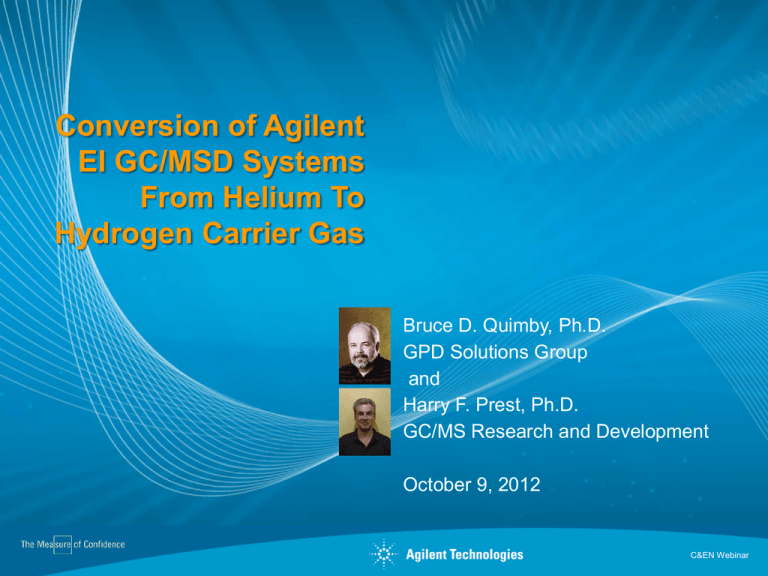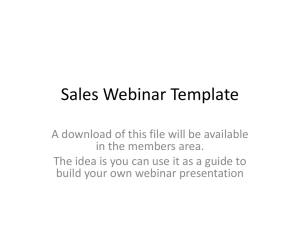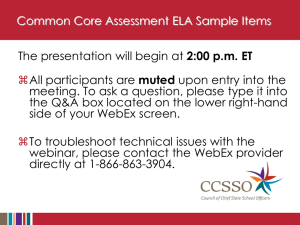Conversion of Agilent EI GC/MSD Systems from Helium to Hydrogen
advertisement

Conversion of Agilent EI GC/MSD Systems From Helium To Hydrogen Carrier Gas Bruce D. Quimby, Ph.D. GPD Solutions Group and Harry F. Prest, Ph.D. GC/MS Research and Development October 9, 2012 C&EN Webinar Question: Have You Ever Tried Converting Your GC/MS From Helium To Hydrogen Carrier Gas? Answer 1: “No. Never thought of trying it. Too busy.” Answer 2: “We did that several years ago. It took some effort, but it has been working fine.” Answer 3: “We tried it once. The results were horrible and confusing! We had a very high background, high noise, and very bad peak shapes. After 4 days, we went back to helium.” C&EN Webinar 2 October 9, 2012 Introduction: Converting from He to H2 Carrier Gas Many GC/MS users are considering changing from helium to hydrogen carrier gas due to price/availability problems with helium. – Read Chemical and Engineering News - July 16, 2012 (Page 32-34) This talk describes the steps recommended for converting EI GC/MS methods. It is important to recognize the differences with using hydrogen carrier. Time should be allotted for adapting the method, optimization, and resolving potential problems. Areas that will need attention include: – – – – – – – choice of supply of H2 remove/bypass carrier gas filter (may be re-installed later if needed) GC/MSD hardware changes choosing new chromatographic conditions potential reduction in signal-to-noise ratio (2-5x) changes in spectra and abundance ratios for some compounds activity and reactivity with some analytes C&EN Webinar 3 October 9, 2012 Introduction: Converting from He to H2 Carrier Gas Methods that will generally require less optimization include analytes that are: – “durable” compounds – at higher concentrations – analyzed with split injections – derivatized Methods that will generally require more optimization include analytes that are: – “fragile” compounds – at trace concentrations Allow time for necessary updates to SOPs and validation C&EN Webinar 4 October 9, 2012 H2 Safety C&EN Webinar 5 October 9, 2012 Letter from Agilent Safety Engineer: Describes H2 Safety Features of Agilent GCs C&EN Webinar 6 October 9, 2012 Designed for Reliability – H2 Safety Safety Shutdown When gas pressure set points are not met, the valve and heater are shut off to prevent explosion Flow Limiting Frit If valve fails in open position, inlet frit limits the flow Oven ON/OFF Sequence Fan purges the oven before turning on heater to remove any collected H2 Explosion Test GC and MS designed to contain parts in case of explosion C&EN Webinar 7 October 9, 2012 Safety First: Read This Before You Start G3170-90010 C&EN Webinar 8 October 9, 2012 Source of H2 Carrier and Plumbing C&EN Webinar 9 October 9, 2012 Source of Hydrogen: Use a Hydrogen Generator Higher initial expense than cylinders, much lower cost over time Very clean H2, >99.9999% available More consistent purity Safety considerations – H2 is only generated at needed pressure (like 40 psig) – Flow is limited (like 250 mL/min) – Auto-shutdown if set point pressure cannot be maintained – Minimal stored gas (like 50 mL at 40 psig) of H2 at any one time Make sure to buy a good one with a low spec for water and oxygen C&EN Webinar 10 October 9, 2012 Hydrogen Generation This is an example of the type of generator to use for H2 carrier gas. Look for generators with a >99.9999% specification and low individual specs on water and oxygen. C&EN Webinar 11 October 9, 2012 Plumbing the Instrument Chromatographic quality stainless steel tubing is often recommended for H2 plumbing and is probably the best choice if available. Users may have to follow local codes or internal company guidelines. We have also used new 1/8th copper that has been cleaned for GC use. Dirty tubing will cause huge contamination problems, as H2 appears to carry dirt out of metal more than He does. Don’t use really old copper tubing, as it becomes brittle and can break. Note that MSD leak checks will not always find big outgoing leaks. Leak check when complete with electronic leak detector. When plumbing a H2 generator, start out with no traps. Only add traps if needed. Make sure the water and oxygen levels are low enough. C&EN Webinar 12 October 9, 2012 Split Vent and Septum Purge Vent Should be Connected to Exhaust C&EN Webinar 13 October 9, 2012 MS Components Required for Conversion: Magnet and Draw Out Lens C&EN Webinar 14 October 9, 2012 Check the Magnet in the 5975 If the magnet in the 5975 does NOT have a serial number along the left edge (as viewed through the source window), it is suitable for use with Helium, but not Hydrogen. If not, please contact your Agilent service engineer to change it to a Helium and Hydrogen compatible magnet before converting the system to H2 carrier. Note: All 5973 magnets are compatible with both He and H2 C&EN Webinar 15 October 9, 2012 Replace the Standard 3 mm Draw Out Lens With the Optional Hydrogen Draw Out Lens G2589-20045 Hydrogen Draw Out Plate, Inert Standard 3 mm Draw Out Plate, Inert C&EN Webinar 16 October 9, 2012 Choosing a Column and Method Conditions C&EN Webinar 17 October 9, 2012 MSD Pumping Capacity for H2 is Less than for He This Limits Column Choice These are approximate values for the 5975. Maximum flow of H2 to maintain reasonable source pressure: – Performance turbo: 2 mL/min – Standard turbo: 1 mL/min – Diffusion pump: 0.75 mL/min – Pressure pulsing: turbo < 3 mL/min, diffusion < 2.5 mL/min It is very helpful to have an ion gauge on the MS to monitor the vacuum vs. column flow. Try to avoid flows that produce pressures higher than 5 x 10-5 torr. You can get useful data above this pressure, but performance may start to degrade C&EN Webinar 18 October 9, 2012 Guidelines for Choosing Column Dimensions and Flows for Method Converted from He to H2 Determine max flow of H2 into MS that will give source pressure of 5 x 10-5 torr or less source pressure. This is your max column flow. Choose column dimensions at initial oven temp of method to give: − a flow < max column flow for vacuum pump − a flow > min column flow for efficiency − an inlet pressure of at least 5 psig Keeping a temperature ramp of the same number of °C/void time will give similar elution order. Use the Agilent method translator for this. These are only approximate guidelines. Sometimes you may have to deviate from them. C&EN Webinar 19 October 9, 2012 Van Deemter Curves If the flow of He or H2 is too low, you loose efficiency MUCH FASTER than if it is too high. This is why operating at or above minimum linear velocity is important. Use 35 cm/sec as minimum for H2 C&EN Webinar 20 October 9, 2012 Column Choice When in doubt (or a hurry) use: − Use 20m x 180 um column and set constant flow at 0.3-0.5 mL/min. − Try to get a linear velocity of at least 35 cm/sec Try to use the same phase and phase ratio to get similar elution order. Smaller bore columns have lower capacity. You may have overloading on high level calibration standards, or samples You may need to use pulsed injection to load sample into small bore columns when using a low flow rate. The flow range for your H2 setup is limited on the low side by the flow to get 35 cm/sec and on the high side by the vacuum pump capacity C&EN Webinar 21 October 9, 2012 Using the Agilent Flow Calculator: Set Linear Velocity to 35 for H2 Carrier If Inlet Pressure Too Low, Raise Flow Inlet pressure is too low Set inlet pressure to 5 psig C&EN Webinar 22 October 9, 2012 Using the Agilent Method Translator: 30m x 0.25 mm id x 0.25 um Checkout Column with Perf Turbo Meets flow requirements for pump and column efficiency with 2x speed gain C&EN Webinar 23 October 9, 2012 Using the Agilent Method Translator: With Perf Turbo and Std Turbo For 20m x 0.18 mm id x 0.18 um Column: − Meets flow requirements for standard turbo pump. − Flow here is chosen to give a 2.5 x speed gain. C&EN Webinar 24 October 9, 2012 Initial Startup with Hydrogen C&EN Webinar 25 October 9, 2012 Initial Problems with Switching GC/MS Methods to from He to H2 Carrier Gas High background that looks like hydrocarbons Reduced signal to noise (worse MDL) Significant tailing for many compounds C&EN Webinar 26 October 9, 2012 Switch to H2 1st Problem: High Background You will see this throughout work with H2. • It will get much smaller with time and use. • It used to takes days or weeks for background to fall to acceptable levels. Agilent developed a new conditioning protocol to clean-up the background much faster. (see later slide) C&EN Webinar 27 October 9, 2012 GC/MS Toxicology Analyzer Checkout Sample 1 2 3 4 5 6 7 8 9 10 11 12 13 14 Amphetamine Phentermine 5 ng/uL Methamphetamine Nicotine Methylenedioxyamphetamine(MDA) Methylenedioxymethamphetamine(MDMA) Methylenedioxyethylamphetamine Meperidine Phencyclidine Methadone Cocaine SKF-525a (RTL Compound) 9 Oxazepam Codeine 8 4 2 10 each compound 17 15 18 22 14 20 19 1 4 23 24 26 27 28 13 5 2 25 21 6 Lorazepam Diazepam Hydrocodone Tetrahydrocannabinol Oxycodone Temazepam Flunitrazepam Diacetylmorphine Nitrazepam Clonazepam Alprazolam Verapamil Strychnine Trazodone 16 12 11 7 3 15 16 17 18 19 20 21 22 23 24 25 26 27 28 6 8 10 12 14 16 18 C&EN Webinar 28 October 9, 2012 Switch to H2 2nd Problem – Peak Tailing Abundance 2000000 1800000 1600000 20m x 0.18mm id x 0.18 um DB-5MSUI 1400000 1200000 Hydrogen 1000000 800000 600000 400000 200000 Time--> 0 Abundance 3000000 2800000 2600000 2400000 2200000 2000000 1800000 1600000 1400000 1200000 1000000 800000 600000 400000 200000 0 Time--> 2.00 3.00 4.00 5.00 6.00 7.00 8.00 9.00 10.00 11.00 12.00 13.00 Helium 4.00 6.00 8.00 10.00 12.00 14.00 16.00 18.00 Immediately after conversion to H2, peak shapes on TIC are poor and tailing badly. C&EN Webinar 29 October 9, 2012 Switch to H2 3rd Problem: Spectrum Changes over Peak Profile There is More Happening Here than Simple Peak Tailing Cocaine 7.20 7.40 7.60 7.80 8.00 8.20 Peak Spectrum Abundance 8.40 8.60 8.80 9.00 Tail Spectrum Abundance Average of 8.018 to 8.036 min.: ToxCKO_H2_4.D\data.ms 82 182 24000 22000 Average of 8.048 to 8.085 min.: ToxCKO_H2_4.D\data.ms 91 14000 20000 12000 18000 16000 10000 Cocaine 14000 12000 10000 105 8000 41 64 55 4000 68 2000 m/z--> 78 6000 4000 6000 0 Not Cocaine 8000 42 40 60 80 303 198 122 152 167 272 135 215 230 244 259 288 327 341 100 120 140 160 180 200 220 240 260 280 300 320 340 m/z--> 115128 167 141 154 2000 0 40 60 191 207221 242 265 281 300314327341 80 100 120 140 160 180 200 220 240 260 280 300 320 340 C&EN Webinar 30 October 9, 2012 Main Ions of Cocaine Do Not Tail. Tail Made Up of Other Ions Tail is different than peak. May be formed from catalytically shredded main component. This problem is reduced with time Cocaine Tail is not cocaine ions C&EN Webinar 31 October 9, 2012 H2 Conversion Considerations for Success C&EN Webinar 32 October 9, 2012 Agilent’s Recipe for H2 Success: Minimizing the Time for Chromatography and Background to Stabilize 1. Have a good source of clean hydrogen like a >99.9999% purity hydrogen generator. 2. Keep H2 flow limited to value suitable for your pumping system 3. Use optional Hydrogen draw out lens 4. After setup, purging and pump down: – Set the source to max temp for your source (check to see what yours is) – Reduce the EMV to 800V – Leave the FILAMENT ON overnight. This cleans up background rapidly. 5. Peak shape will be much better and background will be much lower in the morning. 6. Lower the source temp to method value, retune, and run some samples 7. It is a good idea to have an extra set of filaments on hand in case one burns out. This hasn’t been a problem, but a good idea. C&EN Webinar 33 October 9, 2012 Agilent’s Recipe for H2: Success • Peak Shape Much Better • Background is Lower • Better Signal-to-Noise Abundance 2600000 2400000 2200000 2000000 1800000 1600000 1400000 1200000 1000000 800000 600000 400000 200000 2.00 3.00 4.00 5.00 6.00 7.00 8.00 9.00 10.00 11.00 12.00 13.00 14.00 Time--> C&EN Webinar 34 October 9, 2012 Agilent Toxicology Analyzer Features: • Configured, tuned and tested for the application • Retention time locked (RTL) with DRS database • Constant flow to MS • Backflush to reduce cycle time and remove matrix artifact Challenge: • Convert from He to H2 carrier without altering performance criteria C&EN Webinar 35 October 9, 2012 He Constant Flow Toxicology Analyzer Parameters: • Constant Flow to MS • RTL DRS Method Liquid Injector AUX EPC Vent S/S Inlet ~12psi 1m x 0.15 mm id 1.7 mL/min Column PUU 7890A GC 5975C MSD 15 m X 0.25 mm id X 0.25 um DB-5MSUI C&EN Webinar 36 October 9, 2012 H2 Constant Flow Toxicology Analyzer Parameters: Constant Flow to MS RTL DRS Method Liquid Injector No Change in Performance AUX EPC Vent S/S Inlet ~8psi 0.81m x 0.12 mm id 1.7 mL/min Column PUU 7890A GC 5975C MSD 15 m X 0.25 mm id X 0.25 um DB-5MSUI C&EN Webinar 37 October 9, 2012 Converting Toxicology Analyzer from He to H2 Abundance Toxicology Check Out Mix 1200000 1000000 Helium 800000 600000 400000 200000 0 3.00 4.00 5.00 6.00 7.00 8.00 9.00 10.00 11.00 12.00 13.00 14.00 Time--> Abundance 1200000 1000000 800000 Hydrogen 600000 400000 200000 0 3.00 4.00 5.00 6.00 7.00 8.00 9.00 10.00 11.00 12.00 13.00 14.00 Time--> C&EN Webinar 38 October 9, 2012 Switching GC/MS Methods to from He to H2 Carrier Gas Reduced high background that looks like hydrocarbons Improved signal-to-noise relative to pre-conditioned state Reduced tailing for many compounds C&EN Webinar 39 October 9, 2012 Performance Expectations C&EN Webinar 40 October 9, 2012 Performance Expectations Signal-to-noise ratio is often worse by about 2-5 x. This obviously varies from compound to compound While most spectra remain same, there are always exceptions. Users should check the reference spectra for important targets to make sure they have not changed Same comment for target/qualifier ratios Some compounds may disappear at low levels. Examples include: some nitrogen and oxygen containing compounds (alcohols, aldehydes, ketones) like those found in flavor samples C&EN Webinar 41 October 9, 2012 Library Match Factors – Helium and Hydrogen Carrier Gas Comparison Dichlorvos Mevinphos Ethalfluralin Trifluralin Atrazine BHC-gamma (Lindane, gamma HCH) Chlorpyrifos-methyl Heptachlor Malathion Chlorpyrifos DDE, p,p'Dieldrin Hexazinone Propargite Leptophos Mirex Fenarimol Coumaphos Etofenprox (Ethofenprox) NIST (Forward) Helium Hydrogen 924 867 925 852 927 897 897 856 914 901 925 858 922 897 926 851 916 836 901 890 934 903 926 903 901 832 851 821 884 847 903 881 905 872 864 804 906 842 NIST (Reverse) Helium Hydrogen 929 904 973 967 927 897 897 857 915 908 931 878 926 908 929 856 953 846 902 892 946 940 927 903 906 912 857 829 884 847 914 934 908 877 870 813 916 843 In general, these 20 spectra in hydrogen carrier show lower match factors than in helium carrier gas. They can still be properly identified in library search. C&EN Webinar 42 October 9, 2012 Lindane Helium Carrier Gas Observations • Ion ratios changed • Extra peaks in H2 NIST Forward Match = 925 Hydrogen Carrier Gas NIST Forward Match = 858 C&EN Webinar 43 October 9, 2012 Heptachlor Observations • Ion ratios changed Helium Carrier Gas NIST Forward Match = 926 Hydrogen Carrier Gas NIST Forward Match = 851 C&EN Webinar 44 October 9, 2012 Other Considerations: H2 is not an inert gas, and therefore inertness problems will still exist or be worse. Use the lowest inlet temp that works (to reduce reactions with H2) Use pulsed injection, especially with small bore columns Consider using an MMI in cold splitless mode for fragile compounds Using a deactivated S/SL weldments might help (but don’t ever scrub it) Avoid using methylene chloride as a solvent (especially wet). – At higher inlet temps (like >280C), HCl is formed and causes problems. – If must be used, use lowest inlet temp and maybe a deactivated S/SL weldment, or Multimode inlet Avoid carbon disulfide as a solvent Use liners with a taper at bottom to minimize sample contact with gold seal – Use Agilent Ultra Inert Liners. C&EN Webinar 45 October 9, 2012 Hydrogen Carrier Summary 1. Get a GOOD hydrogen generator and plumb it properly 2. Pick a column that meets the flow needs of method and MSD pump 3. Do magnet update (if necessary) and install Hydrogen draw out lens 4. After purging and pump down, set source to max temp and EM to 800V. Leave filaments on all night. 5. Reset source temp, retune, and run samples. Run practice samples for a few days to make sure system has stabilized 6. Source cleaning will be needed much less frequently C&EN Webinar 46 October 9, 2012 Thank You for Your Attention For additional information please visit: http://www.agilent.com/chem/heliumupdate C&EN Webinar 47 October 9, 2012






